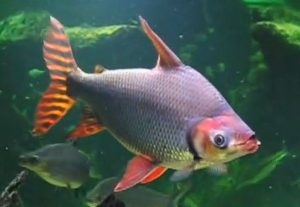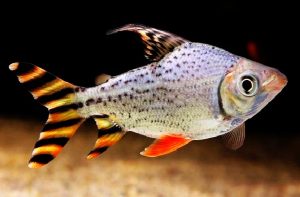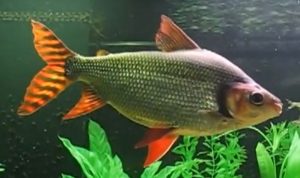The Flagtail Prochilodus (Semaprochilodus insignis) known to tropical fish keeping enthusiasts and Brazilians as Jaraqui, is endemic to Brazil, Colombia, Ecuador, Guyana, and Peru.
Flagtail Prochilodus (Semaprochilodus insignis) are quite common and one of the most widely distributed shoaling species found in South America, where they are locally utilized as a food fish.
Twice each year, huge shoals of Flagtail Prochilodus migrate over several hundred miles, foraging on organic detritus that they sift from the sediment along their migratory route.
The start of the wet season sparks the first spawning migration from the nutrient poor black water streams and tributaries to the silt laden turbulent white waters of the larger river head waters where spawning takes place.
During this period, the fish can be seen leaping in the rapids like salmon. After spawning, the fertilized eggs drift downriver into the nutrient rich floodplains that act as a nursery for the fry, where they feed and grow into juveniles.
Unlike salmon that die after spawning, adult Flagtail Prochilodus return to the exact same spot in the flooded forest tributary or stream where they came from, to feed for the next 3 or 4 months.
The second mass migration takes place during the middle of the wet season. Adult Semaprochilodus insignis will again travel upstream into the whitewater rivers and tributaries where they remain in the area until the water levels drop. When water levels begin to rise again, the fish will spawn in the mouths of the tributary that they are currently in, and the cycle continues.
Adult Flagtail Prochilodus have a silvery torpedo shaped body, a red and black striped patterned tail, and red to orange anal and pelvic fins.
Semaprochilodus insignis and Semaprochilodus taeniurus both have black spots on their flanks as juveniles and are often confused with each other at that stage.
However, as adults Semaprochilodus insignis lose the dark flank spots that adult Semaprochilodus taeniurus retain. Adult females are identical to males but have rounder bellies.
Juvenile Flagtail Prochilodus can be housed in a 55 gallon aquarium, however at least a 100 gallon or larger tank is recommended for adults.
Because they are aggressive towards their own kind in smaller numbers, Flagtail Prochilodus are best kept in an Amazon riverine biotope setting in groups of at least 6 or more individuals with a sandy or fine gravel substrate, some medium to large river rocks, and several large pieces of driftwood or bogwood.
Any type of soft leaf live plant will be eaten and are not recommended, but they need a “grow light” or other adequate lighting to promote the growth of algae that they graze on, and a tightly fitting tank cover to prevent them from jumping from the aquarium.
Because they require good water quality, a large outside wet/dry biological filtration system is highly recommended to take care of the biological load, and a powerhead to provide some water movement in the tank.
Flagtail Prochilodus can also be housed as single specimens, or in a community environment with other larger species such as Loricariids, peaceful cichlids, larger characins, knifefish, etc.
Flagtail Prochilodus are egg scatterers that in the wild migrate long distances to spawn in turbulent white water environments. To date, there have been no reports of them spawning in an aquarium environment, and because of the difficulty in replicating their spawning conditions, it is highly unlikely.
In the wild, Flagtail Prochilodus are primarily herbivores that forage on organic detritus as they migrate. They have an additional stomach that is filled with mud to aid them in processing the large amounts of organic sediment they ingest.
In an aquarium environment, they will accept algae wafers, most quality dried foods, live, frozen, or freeze dried bloodworms
, brine shrimp
, Daphnia
, and copious amounts of vegetable matter. They will eagerly accept blanched lettuce, cucumbers, spinach, etc.
Flagtail Prochilodus are not a commonly available in tropical fish keeping shops but can usually be special ordered or purchased online as juveniles. They are usually quite pricey.
Minimum Tank Size: 100 gallons
Care Level: Moderate
Temperament: Peaceful
Aquarium Hardiness: Moderately Hardy
Water Conditions: 73-84 °F°, 1 – 15°H, pH 5.5 – 7.2
Max. Size: 14″
Color Form: Silver, Black, Red
Diet: Omnivorous (primarily Herbivorous)
Compatibility: Aggressive to conspecifics
Origin: Brazilian Amazon
Family: Prochilodontidae
Life Span: 10 years
Aquarist Experience Level: Intermediate





